RTL-SDR Blog V4 Dongle Initial Release!
NOTE: The V4 is now out of stock but will return in late September. There will be stock for about a year of sales. It is not completely gone yet as per false rumors!
We're happy to announce the first release of our new RTL-SDR Blog V4 dongle which is based on the R828D tuner chip. The pricing is US$39.95 for the V4 dongle with antenna set, and US$29.95 for the dongle only, including free shipping to most countries.
Currently we are only shipping this model from our warehouse in China and the initial production batch is small and so we are limited in stock. However, now that we have confirmed that production of the first small batch of V4 has gone very well, we will be ramping up production, and stocking Amazon USA within 1-2 months as well.
The units are available for purchase on our store page.
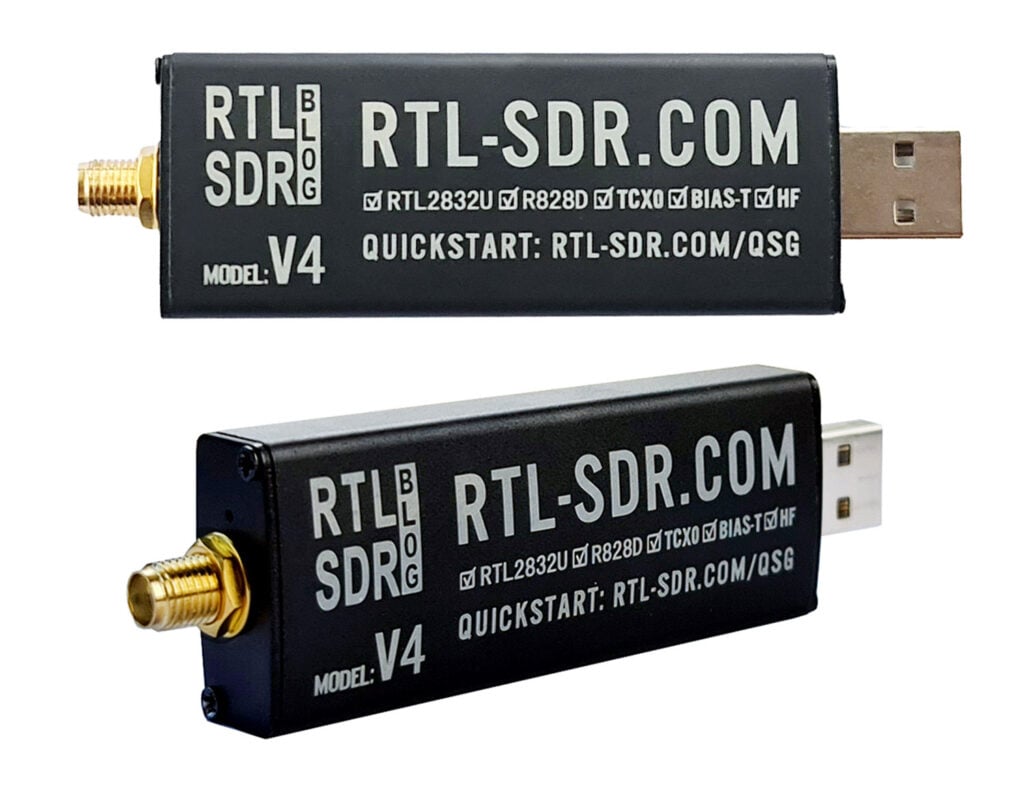
The V4 comes with several improvements and changes that are listed below.
- Improved HF Reception. Now uses a built in upconverter instead of using a direct sampling circuit. This means no more Nyquist folding of signals around 14.4 MHz, improved sensitivity, and adjustable gain on HF. Like the V3, the lower tuning range remains at 500 kHz and very strong reception may still require front end attenuation/filtering.
- Improved filtering. The V4 makes use of the R828D tuner chip, which has three inputs. We triplex the SMA input into three bands, HF, VHF and UHF. This provides some isolation between the three bands, meaning out of band interference from strong broadcast stations is less likely to cause desensitization or imaging.
- Improved Filtering x2. In addition to the triplexing, we are also making use of the open drain pin on the R828D, which allows us to add simple notch filters for common interference bands such as broadcast AM, broadcast FM and the DAB bands. These only attenuate by a few dB, but may still help.
- Improved phase noise on strong signals. Due to an improved power supply design, phase noise from power supply noise has been significantly reduced.
- Less heat. Due to the improved power supply design the V4 uses slightly less current and generates slightly less heat compared to the V3.
- Cheaper price! The price of the R860 chip which is used in the V3 and most other RTL-SDR brands increased significantly at the beginning of 2023 which is part of the reason as to why RTL-SDR dongles have been increasing in price recently. For the V4 we are making use of an existing stockpile of R828D chips which are now priced cheaper than new productions of the R860. In a time when high inflation keeps pushing prices up this is incredibly welcome.
There are some other minor changes including a new bias tee LED and a small cutout hole in the enclosure so it's easy to tell when the bias tee is on.
Of course the same innovations that we brought in with the V3 are still implemented such as the sleek conductive black metal enclosure which works as a shield and doubles as a heatsink, a thermal pad to sink heat away from the PCB, 1PPM TCXO, SMA connector, USB noise choking and improved ESD protection.
The V4 however does come with some disadvantages compared to the V3 that need to be noted:
- Due to the increased filtering there can be an average of 2-3 dB less sensitivity on some bands. Please see the MDS measurement graph below for the full picture.
- The V4 requires the use of our RTL-SDR Blog drivers. Our RTL-SDR blog drivers are on GitHub. Please be sure to follow the installation instructions on the quickstart guide carefully as the V4 will not work with default Osmocom drivers. In most cases using our drivers simply means running our install-rtlsdr-blog.bat file, or replacing a dll file. (We are working to upstream the main changes to the Osmocom repo too). MacOS and Android users please note that we don't have a solution for you yet, but we are working on it.
- The V4 is a Limited Edition Design. The R828D tuner chip is completely out of production now and the number of units we can produce is limited by the number of chips held by our contract manufacturer in China. They have indicated that there should be enough stockpile for about a years worth of production.
Because of these tradeoffs we will continue selling the V3 alongside the V4.
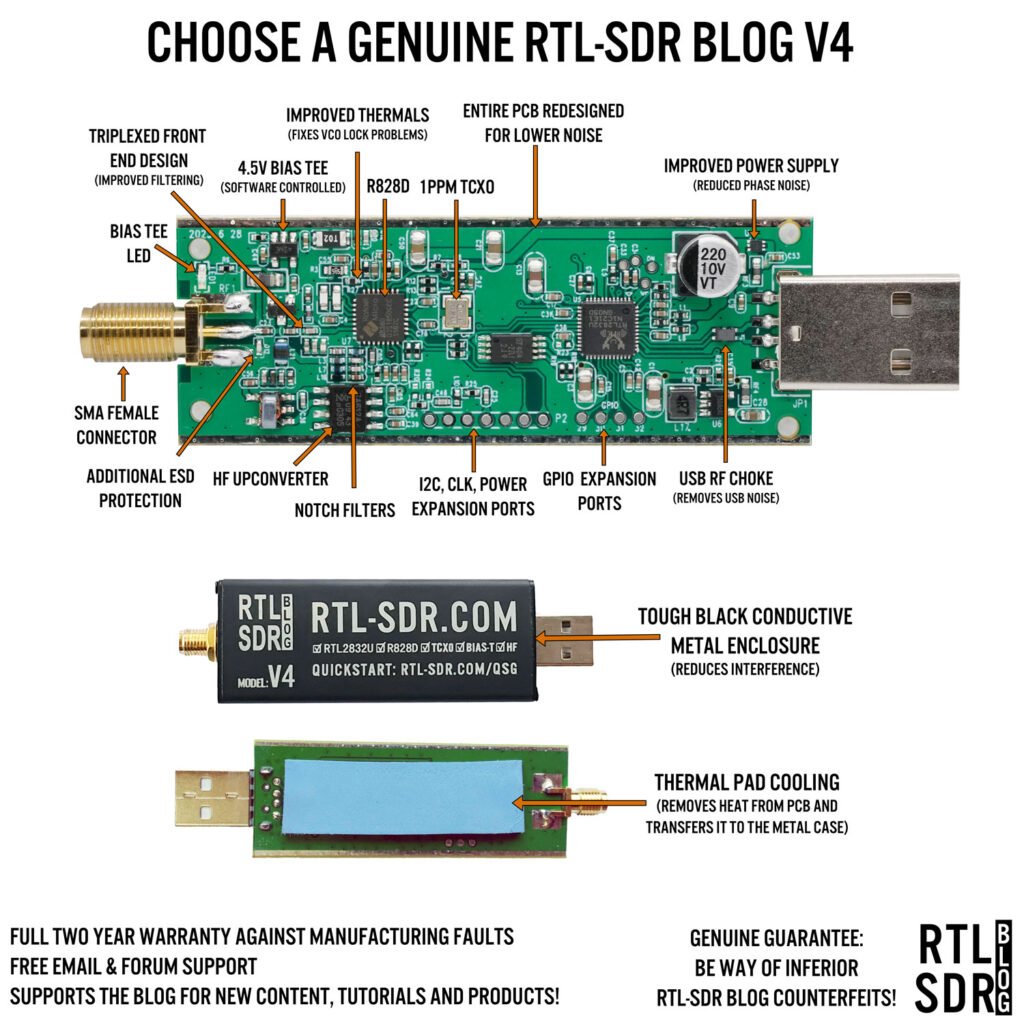
More About the V4 Design
The R828D
The core change on the RTL-SDR Blog V4 design is the change from the R860 tuner chip to the R828D tuner chip. The R828D was previously a more expensive chip, however with the huge price increases on the R860 which came in effect at the beginning of the year we have decided to make use of existing R828D stock which is now cheaper than the R860.
The R828D is very similar to the R820/R860 and shares much of the same circuitry. However, instead of just one input, it comes with three switchable inputs. We have used these three inputs together with a triplexer to create a dongle with some extra input filtering. In the past there have been some R828D based dongles on the market, but all designs are based on TV receiver circuits. Because our design is different, you will need to use our RTL-SDR Blog driver branch which has added compatibility for our R828D design.
Also please note that because the R828D chip stock is limited, and it is no longer in production, the V4 design is also a limited design which we expect to be able to sell for about a year.
HF Design
The HF design consists of a SA612 double-balanced mixer circuit with front end filtering, which is connected to the 28.8 MHz oscillator that is also used for the tuner and RTL2832U chip. This means that HF frequencies are upconverted by 28.8 MHz. Our drivers handle this upconversion seamlessly, so you just need to tune to 0 - 28.8 MHz in order to receive HF. There is no need to set any offset.
An upconverter design also means that unlike direct sampling full gain control is available, and also there is no folding of signals across 14.4 MHz due to Nyquist.
Adding Basic Input Filtering
One of the main problems with RTL-SDR dongles is overload from strong broadcast stations such as broadcast FM, broadcast AM and DAB. By using a triplexer circuit we can make use of the three inputs on the R828D tuner chip to provide some filtering. The triplexer splits the input signal into HF (0 - 28 MHz), VHF (28 MHz - 250 MHz), and UHF+ (250 MHz - 1.766 GHz). This means that interference from something like strong broadcast FM at 88-108 MHz is more isolated when we are tuned to the HF and UHF bands.
We've also made use of the open drain pin on the R828D (which does not exist on the R860) to implement a simple switchable notch filter for the main problem broadcast bands. These notch filters cover broadcast AM, broadcast FM and DAB, and reduce them about an additional 5-10 dB. By default the notch turns ON when tuned out of these bands, and is turned OFF when tuned within them.
In terms of sensitivity, the disadvantage of adding more filtering is that it can reduce sensitivity in some bands. However, sensitivity of the RTL-SDR is usually not a problem in most situations, as we're usually limited by desensitization from strong out of band signals as mentioned above. If sensitivity is a priority an LNA such as our wideband LNA should be used anyway, for any RTL-SDR brand or model. Any front end LNA will totally dominate the sensitivity figures, making any sensitivity measurements of the RTL-SDR itself irrelevant.
Revised Power Design
The revised power design makes use of a more modern LDO with significantly better power supply noise rejection which results in much lower phase noise seen on strong narrow signals. There are also some PCB tweaks to reduce internally produced noise. The LDO improvement also has the effect of reducing power usage and lowering heat.
Other Changes
We've also added an LED to the bias tee, so it's easier to tell if it has been activated in software.
MDS Measurements
The minimum discernable signal (MDS) is a test we can do to determine what is the minimum power level that a receiver can detect.
The results show that the MDS has significantly improved on the HF bands thanks to the upconverter design. However, there is some minor degradation in the VHF and UHF band.
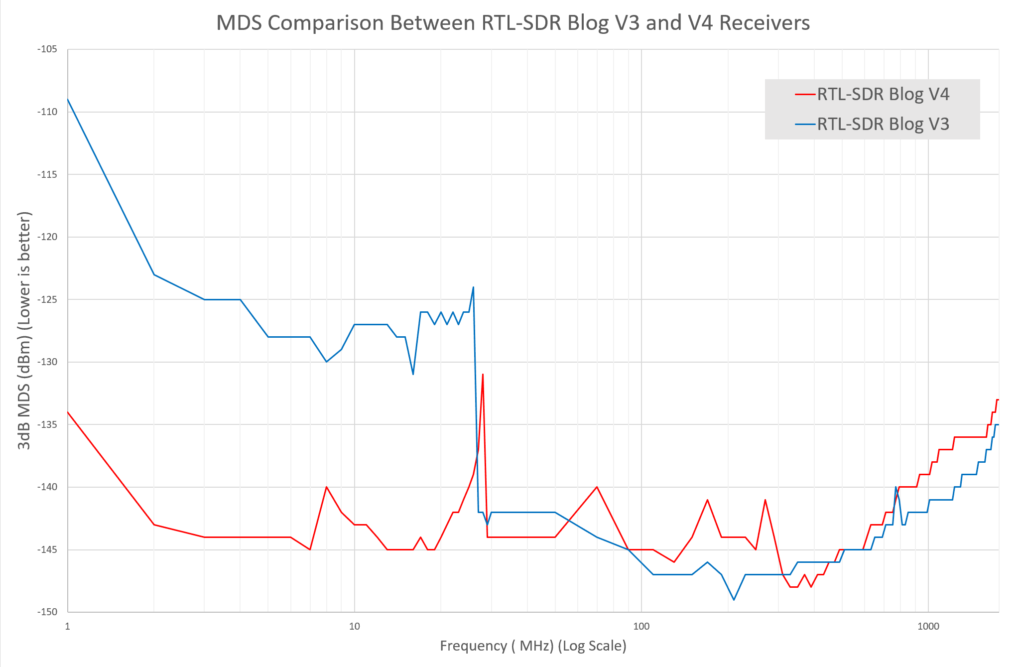
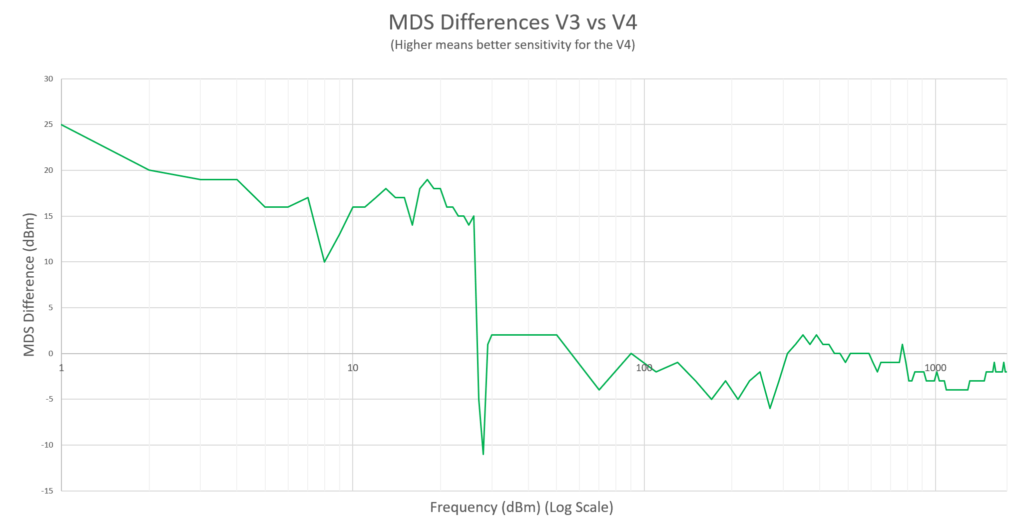
Two Tone Isolation & Desensitization Test
Strong out of band signals can cause an SDR to desensitize on other bands. For example, very strong broadcast FM (which is common), can cause signals being received on other frequencies to be received with a lower signal to noise ratio.
In this test we injected an "interference" tone (Tone A) at 95 MHz, and injected a second tone (Tone B) at another frequency. We then slowly increased the power on Tone A. When we noticed a 3 dB drop in the signal strength of Tone B we recorded the power level of Tone A that this occurred at.
This gives us a way to see the effect of the triplexer filters and notch filters when compared against the Blog V3 which has no filtering. A higher recorded value means that a stronger signal is required to desensitize the receiver, meaning that the strong signal handling capability is improved.
From the difference graph we can see that isolation results within the same triplexer band are improved by about 8 dB thanks to the notch, and then out of band isolation is improved by 28 - 43 dB thanks to a combination of the triplexer filters and notch.
We note that between 305 - 1405 our measurements were limited by the max power out from our signal generator, and we believe the true results are roughly 5dB better than what was recorded at these frequencies.
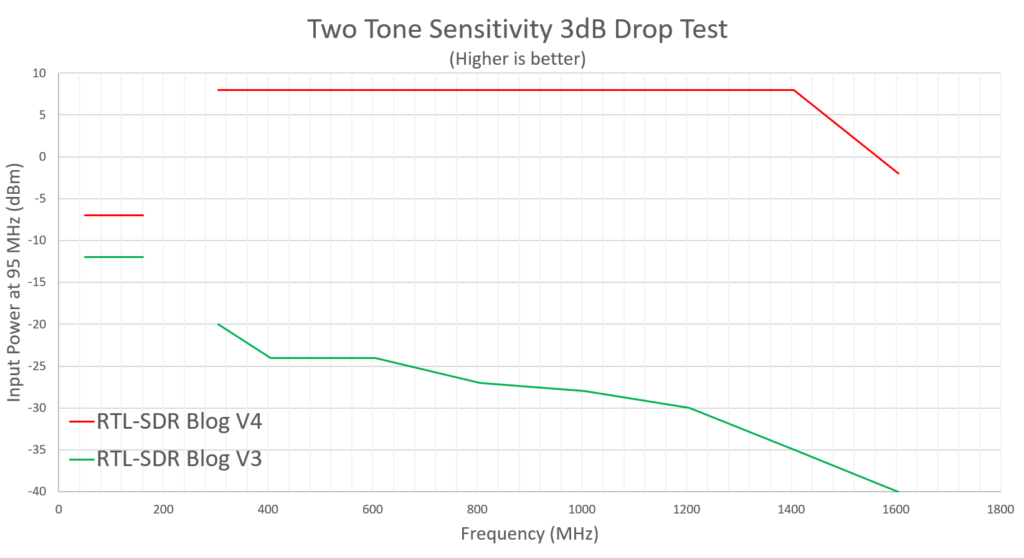
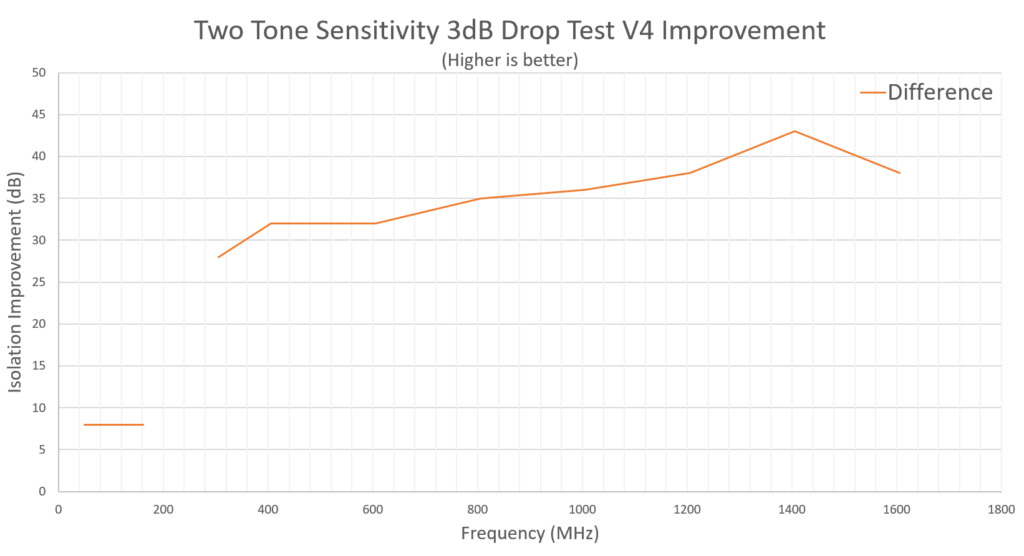
Should I upgrade if I have an RTL-SDR Blog V3?
If you are happy with the RTL-SDR Blog V3's performance, then there is absolutely no need to upgrade as you will likely see similar performance. However, if you are purchasing a new dongle it may be wise to consider the V4 model as we believe the V4 will be a receiver that is more suitable in many situations.
Thanks
We wanted to extend some thanks to Erlend S. Ervik/LB6MI, Jack T. and everyone over the years who has given some input to RTL-SDR design.
What should be the connection scheme for synchronizing multiple V4 dongles? I see that the circuit layout is a bit different compared to V3, thus the tutorial on how to connect clocks of several units is not applicable anymore, I guess. However, I also see that in V4 there is a dedicated 28.8 MHz CLK output that, I assume, can be used for such synchronization purpose. Thanks for the answer.
Should move to a Female USB C port. So one can use a USB C to USB C cable directly to a phone, tablet or laptop. I have seen people comment that its not need as it doesn’t draw that much power. It isn’t a power requirement thing/issue it is a get up to current with ports. My Linux 2 in 1 tablet is all USB C, My Phone is and I think the universal standard is now USB C and even my daily laptop I have to use a docking station or adapter to get a USB A port.
V.4 Not working on Mac.. Running Cubic SDR.
CubicSDR is not compatible, the author hasn’t updated the software in a while and it won’t work with the Blog V4 until he does. But there are other programs like SDR++, GQRX and SDRAngel which have been updated. Please see the V4 guide at https://www.rtl-sdr.com/V4
Cubic SDR works perfectly with RTL-SDR v4 in Pothos win environment (Pothos SDR development environment).
https://github.com/pothosware/PothosSDR?tab=readme-ov-file
I have a V3 hoping to get a V4. RTL-Sdr works allways.
I tried to use RTL-SDR v4 with MATLAB. The hardware set up from the add-on manager is not able to recognize the device on my Mac. The Matlab version is 2023b.
I installed drivers from the GitHub and the rtl_test -t command works fine.
Earlier I was using V3. But I uninstalled it on Matlab as the driver on my laptop.
Any guidance is much appreciated to help me use V4.
Hi there,
I am excited to embark on my journey into ham radio. After careful consideration, I’ve concluded that SDR is the best option for me. However, I’m currently undecided between purchasing the V3 or the V4. I have already reviewed the advantages and disadvantages of the V4 compared to the V3. What’s holding me back is the feedback I’ve come across regarding potential difficulties with installing drivers for the V4. Although these issues are typically resolved, as a beginner, I’m unsure if the V4 is the ideal choice for me to start with. What would you suggest? Additionally, I’ve noticed many projects of interest specifically utilizing RTL-SDR with the V3. Can you confirm if the V4 is compatible with all software just like the V3? I am just ready to purchase it, as soon as I resolve this questions.
Any assistance or advice you could provide would be greatly appreciated. Thank you in advance.
Warm regards,
The V4 kit is nice. This is my first SDR and I’m easily able to listen to AM radio around 14 kHz. All the tutorials assume that an RTL-SDR can’t tune that low. It’s very easy in SDR#. Works in GNU Radio Companion too. The rabbit ears work well. I got myself a shielded USB extension – it would be nice if that was included in the kit.
Looking forward to the USB-C Dongle (V5?)
I really like the RTL-SDR Blog v4. I remember a long time ago sitting here wishing for an RTL-SDR that can tune seamlessly below 24MHz. My wish came true. It is also incredibly sensitive on shortwave. It is receiving signals at no rf gain, no RTL-AGC, and no Tuner AGC enabled. It does not need a lot of gain to reach a listenable level, too.
Even though there can still be imaging from overloading, this is the best RTL-SDR I have ever bought!
I am in hopes that RTL-SDR Blog is working on a new tuner like the R828D that has multiple inputs and just as sensitive. The RTL-SDR Blog v4 is what all variations of the RTL-SDR dongle should have been years ago.
Thanks, RTL-SDR Blog for a great working product!
Any updates on the Amazon-stocking timeline? I would love to dive into the SDR world, but feel like I should wait for V4 to be readily available!
Ditto!
really looking forward to this being back in stock. Very cool
Back in stock – > Chinese worldwide warehouse
Thank you for designing and manufacturing the rtl-sdr Version 4. I’ve been having a great time receiving some exotic DX Catches using this dongle on the HF and UHF Bands. My age is 71 and I have been a SWL since being a kid 9 years of age. Using the rtl-sdr V4 has brought me back to those times when I greatly enjoyed digging for weak DX.
I’m not new to SDR as I purchased a SDRplay RSP1A some years ago. The RSP1A uses Cubic SDR as a GUI. Although the RSP1A sells for quite a bit more than the rtl-sdr V4, and has decent Bandpass Filters built in, the rtl-sdr V4 beats it in sheer sensitivity.
Initially, I had some problems installing the software for the rtl-sdr V4. I use Linux Mint. The portion of the Install where you are directed to remove any old, existing Drivers is where I had a problem. I failed to slow down and read what my Linux Terminal window was telling me. It advised me to use an ADDITIONAL STEP to remove files that were not removed during the initial step, and were no longer needed. After performing this additional step I was able to install GQRX.
The sensitivity of the rtl-sdr V4 is amazing. I can regularly receive a NOAA Weather Broadcast on 162.425 mHz from Forks, Washington – 186 direct miles from my QTH. One of my better receivers is a Uniden BC780XLT. The rtl-sdr V4 is every bit as sensitive as the ‘780XLT. I am not using any type of Bandpass Filter on VHF/UHF and my antenna for these bands is my Ham 144/450 mHz Colinear Antenna, a Cushcraft AR-270. This vertical antenna is mounted on the outside window sill of my 3rd floor apartment. It is nearly right up against the building.
HF sensitivity is also excellent, especially from 6 mHz through 28 mHz. I do use a Bandpass Filter on the HF Bands, in the form of my Ham Radio Antenna Tuner. My HF Antenna is a 65 foot end fed wire running from my window ledge out to an oak tree. The height is about 50 feet above ground.
The Middle-East and Africa are difficult reception areas from my location. Last night I was able to receive HF Aircraft Traffic from the Far East (ARTCC) and local airport traffic from India on the 8.9 mHz Aeronautical HF Band. As a benchmark I used my Drake R-7 receiver side-by-side with the rtl-sdr V4. The Drake was only 1 to 2 s-units better than the rtl-sdr V4. The ability to shape the audio of the rtl-sdr V4 in GQRX – both high cut and low cut, simulates the Passband Tuning of the Drake R-7. In addition, the Noise Blanker in the GQRX GUI is just as effective using the rtl-sdr V4 as the highly regarded Drake R-7 Noise Blanker.
The rtl-sdr V4 cost me $39, with the accessory antennas. The Drake R-7 sold new for $1,295 in 1980 – without the additional filters or noise blanker. That equates to $4,825 in today’s currency. The rtl-sdr V4 gives me the ability to ferret out weak signals that I would usually miss with a conventional receiver. I highly recommend this unit to anyone thinking of purchasing one. KG7M
Thank you for the wonderful review!
You’re very welcome. Now I’ve been using the rtl-sdr for several months, I am still delighted with it’s performance. I have to chuckle because before I purchased the rtl-sdr V4 I was logging pages and pages of 2-way DX contacts (QSO’s) via my Amateur Radio Station. After hooking up the rtl-sdr V4, I’ve had barely a dozen QSO’s in all these months! So now most of my time is spent just listening. I’m running Linux Mint Cinnamon on my PC with GQRX 2.12 as the Interface for the rtl-sdr V4. The ability to visually determine weak signals in a band of interest is fantastic. And I’m not new to SDR as I purchased a RSP1A years ago. The rtl-sdr V4 runs circles around it. This is provided that you place some sort of Bandpass Filter, or Antenna Tuner between your outside antenna and the rtl-sdr V4! I’m using my Station Tuner a MFJ Versa Tuner V, a Roller Inductor Model 989C. Some of my recent exotic catches are CODAR HF Radar on 13.5 mHz, Indonesian 40m Pirates conducting “Horse Races (chanting contest)” in LSB just below 7 mHz, IFRIKYA FM from Algeria on 17.6 mHz, countless HF Aeronautical Traffic from all over the globe in USB and Russian Aeronautical using CW, and various VHF Stations such as Local Township Police Comms up to 150 miles distant.
For new users: don’t expect fantastic results using small antennas. Best results will be had on the HF Bands with a Horizontal Dipole, cut to the frequency of interest (multiple dipoles can be hung from the same center feed to cover many bands – see internet for construction). On VHF a homemade Vertical Dipole, or Coaxial Dipole is a great antenna. If you’re located in a metro area like me, an Antenna Tuner, or Bandpass Filter is a must. This will eliminate any overload from local broadcasters. I also use a homemade RF Attenuator with switchable 5, 10, and 20 db positions, which can be switched in singlely, or in combination. I’ve also used a couple of the inexpensive Chinese Wideband RF Amplifiers and a 4-Output Isolation Distributor ahead of the rtl-sdr V4 with great results. Thank again for a great product!
73, KG7M
For those outside USA / Canada / UK: 186 miles is 300 kilometers or the low end of LEO! For comparison, Iridium’s orbit is 485mi / 781km.
Of course, being in a mountainous environment with (likely) a low noise floor & minimal interference / intermod is tremendously helpful! 😉
What is the bias tee for and how is it used?
It provides DC power to let say LNB, LNA or other active antennas and it does not affect signals traveling same path/coax cable
Does this work well with Youloop?
It will work fine, but generally RTL-SDRs are more suited to an MLA-30 or similar active antenna.
It seems to be working fine for me on the a Raspberry Pi 4B 4GB running Bullseye. I cloned the GitHub repository and recompiled the driver and applications for 64 bit. No problems detected so far. Seems to be perfectly adequate at vhf/uhf as far as sensitivity is concerned but HF obviously requires a much better antenna, suited to the lower frequencies.
Who can I contact to talk about a possible issue when combining V3 and V4 models connected to the same system?
A STRF run using a V3
Running a SatNOGS observation on the same system that uses a V4, when the obs is running one can clearly see the interferance in the STRF run. The times match.
By any chance, are you using hardware AGC?
I have noticed before with NanoVNA, that the impedance does change as you change LNA gain.
No
Contact us at admin rtl-sdr.com with some more details about your setup and what drivers you are using. But in my tests I don’t see any issues with interference from the V4, even with the V4 directly connected to a V3. Do you get something similar with two V3’s?
rtl-sdr.com with some more details about your setup and what drivers you are using. But in my tests I don’t see any issues with interference from the V4, even with the V4 directly connected to a V3. Do you get something similar with two V3’s?
I have send a email
Bandwidth? Can it tune US HDTV ATSC 7 MHz?
No, it’s the same as every RTL stick. It just has improved sensitivity and noise characteristics.
Bandwidth is the same as any other RTL-SDR like the V4, 2.56 MHz max stable. Up to 3.2 MHz with drops. Different RTL-SDR’s will also have the same ADC specs, but the front end can change.
How do You make this go below 24 MHz? Now works as the old one, but won’t
let me go below 24 MHZ. I have installed all the drivers. App is GQRX.
GQRX, in the input control tab. Select “no Limits”
Thanks!
Yep set “no limits”. I’ve submitted patches to gr-osmosdr and soapy to get rid of the artificial limits for the V4 so “no limits” doesn’t need to be checked in the future. But it might be a while before they are accepted.
Houston, we have a problem…
If I want to use two RTL-SDR’s simultaneously to monitor two different bands using a modern USB 3.0 hub,I can’t get it to work.
The hardware/software ID’s clash, so a no go.
What a shame.
Can some kind person who uses several RTL-SDR’s at once show me how to achieve a multi tuner system.
PS: I am not interested in any phase or clock synchronization, before you ask.
Operating system? Software being used? Do they function correctly independently? If the issue is that you cannot distinguish between them then one method is to give each a unique serial number and query the serial number from a script that launches the software.
What software? In most cases all you need to do is set a unique serial number using rtl_eeprom. Same as with any RTL-SDR model/brand.
Change the serial number of one of them using rtl_eeprom. Then you can select which one you want to use by it’s serial number.
# rtl_eeprom -h
rtl_eeprom, an EEPROM programming tool for RTL2832 based DVB-T receivers
Usage:
[-d device_index (default: 0)]
[-m <str> set manufacturer string]
[-p <str> set product string]
[-s <str> set serial number string]
[-b <0,1> disable/enable force bias tee always on (0: OFF, 1: ON)]
[-g <conf> generate default config and write to device]
[ <conf> can be one of:]
[ realtek Realtek default (as without EEPROM)]
[ realtek_oem Realtek default OEM with EEPROM]
[ noxon Terratec NOXON DAB Stick]
[ terratec_black Terratec T Stick Black]
[ terratec_plus Terratec T Stick+ (DVB-T/DAB)]
[-w <filename> write dumped file to device]
[-r <filename> dump EEPROM to file]
[-h display this help text]
Use on your own ri sk, especially -w!
The new RTL-SDR-BLOG Windows Release V1.2 requires pthreadVC2.dll for rtl_adsb.exe, rtl_fm.exe, and rtl_tcp.exe and it is not included.
imho you should report that directly in the “issues” in RTL-SDR Blog github site.
Done.
If you can please raise an issue on GitHub, but I will include that file in the next release.
Done.
what are the physical dimensions? can i connect them nicely to a splitter with a 12.70mm port to port spacing? if yes, then i might buy a bunch of your chinese sticks.
Exactly the same dimensions as the V3:
92mm x 27mm x 13.5mm (including SMA and USB)
71mm x 27mm x 13.5mm (excluding SMA and USB).
oh well too bad… thanks for your response anyway.
i hope you might consider changing this in your next hardware revision.
also, id suggest you to make a nice and concise PDF datasheet for your product*s that lists all information that might be useful (physical size and weight including/excluding the case, protrusion/exact position of the sma and usb connector, power consumption (for heat management), maybe a warning if components are easily ripped off if i decide to remove the case (as it happened with a stick from a different mfg), etc.).
having a datasheet is a godsend, ranks your product orders of magnitude higher in comparison (especially in the category of project-readyness and trustworthyness) to undocumented noname shit (where you have to guess the dimensions by measuring the lengths and widths in respect to some standard connector), and costs only little time to setup (and maintain, if you chose to include HW revision changes into your datasheet)
to sum the latter part up, id rather pay for a well-documented but slightly pricier product than for the undocumented.
there is a different sdr stick mfg which lists a datasheet, but it lacks many details, looks like it was laid out by a child, and the tcxo in the latter revisions doesnt nearly meet the spec (only early revisions seem to have the claimed performance). you can do better than them.
Hey there, nice one. I frequently visit this site since 2013. The first decent sdr i got (my second sdr) was a V3 from your store, so many good memories. (I later discovered that i was more interested in hf so eventually bought an airspy hf+ discovery) I hope you the best! Wish you sell many of them.
Thank you!
I just ordered one. Can you make any suggestions of software that would let me run a remote receiver with it on a Raspberry Pi, KiwiSDR-Online style?
OpenWebRX – https://www.openwebrx.de/
If you’re using the Docker images, just remember to replace the Linux RTL-SDR driver with the rtl-sdr-blog branch and the V4 should work fine. Or if installing from scratch just replace any instructions to install RTL-SDR drivers with instructions to install the rtl-sdr-blog drivers.
Instructions at https://www.rtl-sdr.com/V4
Hi Jordan,
plese visit this one improved OpenwebRX.de called OpenwebRX plus.
Here are lot of improvements, RTTY, AIS, HFDL decoders etc…..
and it is free! Based on HA7ILM project.
Me tested it with Raspberry Pi4 and Airspy Discovery.
https://github.com/luarvique/ppa
73! Ladislav
Using a stockpile of cheap RF chips is pretty impressive resource management, well done.
An indication to me that I’m with a good provider of SDR technology.
Just looking for an excuse to unleash the Kraken…
Hi!
What is the max. reception frequency?
Same as with R820/R860 based devices, up to 1.766 GHz.
Is it available yet on ebay/aliexpress? Can’t find V4 there …
It is on eBay and Aliexpress, please use the eBay and Aliexpress buttons on https://www.rtl-sdr.com/store to get directly to the product page.
Will there be linux support for v4? If not now, what is needed for linux support?
Yes, just install the RTL-SDR Blog drivers via the instructions at https://www.rtl-sdr.com/V4
Damn shame that R848 is NRND.
Native 47 – 2350 MHz coverage in a single stick would have been wild.
It’s listed, so kinda better off than the current ones.
But hard to build with it, unless you are able to find documentation for it.
Has anyone tried compiling/testing the new driver on MacOS?
The driver is just a fork of the Osmocom branch, so whatever methods worked to compile the osmocom drivers on MacOS will work with this one too.
Too bad that this is for limited runs. I like the design of the hardware.
It would be also great if the device can be upstreamed to the Osmocom driver, but it seems like the mainline driver is not actively developed at the moment…
Very nice!
Love it! 🙂
looking forward to giving this a try. My v3’s have been rock solid
woah i love the new color
The black case should emit heat more efficiently than the bare aluminum version, if kept out of sunlight/strong light where it would then absorb heat into the sdr.
Awesome